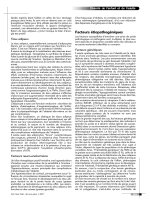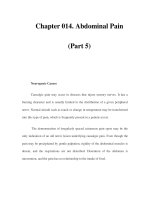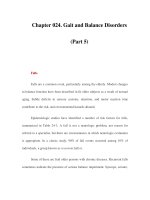Chapter 076. Eating Disorders (Part 5) docx
Bạn đang xem bản rút gọn của tài liệu. Xem và tải ngay bản đầy đủ của tài liệu tại đây (13.85 KB, 5 trang )
Chapter 076. Eating Disorders
(Part 5)
An algorithm for basic treatment decisions regarding patients with
anorexia nervosa or bulimia nervosa. Based on the American Psychiatric
Association's practice guidelines for the treatment of patients with eating
disorders. *Although outpatient management may be considered for patients with
anorexia nervosa weighing more than 75% of expected, there should be a low
threshold for using more intensive interventions if the weight loss has been rapid
or if current weight is <80% of expected.
Less severely affected patients may be treated in a partial hospitalization
program where medical and psychiatric supervision is available and several meals
can be monitored each day. Outpatient treatment may suffice for mildly ill
patients. Weight must be monitored at frequent intervals, and explicit goals agreed
on for weight gain, with the understanding that more intensive treatment will be
required if the level of care initially employed is not successful. For younger
patients, the active involvement of the family in treatment is crucial regardless of
the treatment venue.
Psychiatric treatment focuses primarily on two issues. First, patients require
much emotional support during the period of weight gain. Patients often
intellectually agree with the need to gain weight, but strenuously resist increases in
caloric intake, and often surreptitiously discard food that is provided. Second,
patients must learn to base their self-esteem not on the achievement of an
inappropriately low weight, but on the development of satisfying personal
relationships and the attainment of reasonable academic and occupational goals.
While this is often possible, some patients with AN develop other serious
emotional and behavioral symptoms such as depression, self-mutilation,
obsessive-compulsive behavior, and suicidal ideation. These symptoms may
require additional therapeutic interventions, in the form of psychotherapy,
medication, or hospitalization.
Medical complications occasionally occur during refeeding. Especially in
the early stages of treatment, severely malnourished patients may develop a
"refeeding syndrome" characterized by hypophosphatemia, hypomagnesemia, and
cardiovascular instability. Acute gastric dilatation has been described when
refeeding is rapid. As in other forms of malnutrition, fluid retention and peripheral
edema may occur, but they generally do not require specific treatment in the
absence of cardiac, renal, or hepatic dysfunction. Transient modest elevations in
serum liver enzyme levels occasionally occur. Multivitamins should be given, and
an adequate intake of vitamin D (400 IU/d) and calcium (1500 mg/d) should be
provided to minimize bone loss.
No psychotropic medications are of established value in the treatment of
AN; tricyclic antidepressants are contraindicated when there is prolongation of the
QT
c
interval. The alterations of cortisol and thyroid hormone metabolism do not
require specific treatment and are corrected by weight gain. Estrogen treatment
appears to have minimal impact on bone density in underweight patients, and the
small benefit of bisphosphonate treatment appears to be outweighed by the
potential risks of such agents in young women.
Bulimia Nervosa
Epidemiology
In women, the full syndrome of BN occurs with a lifetime prevalence of 1–
3%. Variants of the disorder, such as occasional binge eating or purging, are much
more common and occur in 5–10% of young women. The frequency of BN among
men is less than one-tenth of that among women. The prevalence of BN increased
dramatically in the early 1970s and 1980s but may have leveled off or declined
somewhat in recent years.
Etiology
As with AN, the etiology of BN is likely to be multifactorial. Patients who
develop BN describe a higher-than-expected prevalence of childhood and parental
obesity, suggesting that a predisposition toward obesity may increase vulnerability
to this eating disorder. The marked increase in the number of cases of BN during
the past 25 years and the rarity of BN in underdeveloped countries suggest that
cultural factors are important. Several biologic abnormalities in patients with BN
may perpetuate this disorder once it has begun. These include abnormalities of
CNS serotonergic function, which is involved in eating behavior, and disruption of
peripheral satiety mechanisms, including the release of cholecystokinin (CCK)
from the small intestine.
Clinical Features
The typical patient presenting for treatment of BN is a woman of normal
weight in her mid-twenties who reports binge eating and purging 5–10 times a
week for 5–10 years (Table 76-3). The disorder usually begins in late adolescence
or early adulthood during or following a diet, often in association with depressed
mood. The self-imposed caloric restriction leads to increased hunger and to
overeating. In an attempt to avoid weight gain, the patient induces vomiting, takes
laxatives or diuretics, or engages in some other form of compensatory behavior.
During binges, patients with this disorder tend to consume large amounts of sweet
foods with a high fat content, such as dessert items. The most frequent
compensatory behaviors are self-induced vomiting and laxative abuse, but a wide
variety of techniques have been described, including the omission of insulin
injections by individuals with type 1 diabetes mellitus. Initially, patients may
experience a sense of satisfaction that appealing food can be eaten without weight
gain. However, as the disorder progresses, patients perceive diminished control
over eating. Binges increase in size and frequency and are provoked by a variety
of stimuli, such as transient depression, anxiety, or a sense that too much food has
been consumed in a normal meal. Between binges, patients restrict caloric intake,
which increases hunger and sets the stage for the next binge. Typically, patients
with BN are ashamed of their behavior and endeavor to keep their disorder hidden
from family and friends. Like patients with AN, those with BN place an unusual
emphasis on weight and shape as a basis for their self-esteem. Many patients with
BN have mild symptoms of depression. Some patients exhibit serious mood and
behavioral disturbances, such as suicide attempts, sexual promiscuity, and drug
and alcohol abuse. Although vomiting may be triggered initially by manual
stimulation of the gag reflex, most patients with BN develop the ability to induce
vomiting at will. Rarely, patients resort to the regular use of syrup of ipecac.
Laxatives and diuretics are frequently taken in impressive quantities, such as 30 or
60 laxative pills on a single occasion. The resulting fluid loss produces
dehydration and a feeling of emptiness but has little impact on caloric balance.









